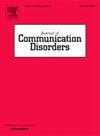隐性听力损失有多隐蔽?charcot Marie牙病患者自我报告的听力问题。
IF 2.1
3区 医学
Q2 AUDIOLOGY & SPEECH-LANGUAGE PATHOLOGY
引用次数: 0
摘要
实验室研究揭示了CMT (Charcot-Marie-Tooth,一种最常见的遗传性神经病变)患者的隐性听力损失,这可能会影响他们的生活质量。目前的研究区分了CMT 1型和2型,前者涉及周围神经脱髓鞘,后者涉及轴突病引起的周围神经功能障碍。研究了CMT1和CMT2在日常交际情境中对听力问题及相关社交和注意问题的影响。方法:收集42例CMT1患者、30例CMT2患者和72例对照者(从135名对照组参与者中选择)的数据,他们填写了关于日常和嘈杂环境下听力、听力困难引起的社交问题和听觉持续注意问题的问卷。结果:CMT2患者似乎只有轻微的听力困难。没有发现对社会和注意力问题有影响。此外,与对照组相比,发现CMT1患者在日常情况下有更多的整体听力困难。CMT1患者报告了严重的听力困难,特别是在嘈杂和混响的环境中。如文献所述,这些问题可能是由潜在的双耳听力问题以及时间和声学信息处理的减少引起的。这些听力障碍与社会问题有关,如社会不安全感,甚至社会回避,以及听觉持续注意力的问题。结论:这些发现强烈提示CMT1影响社会沟通方面的生活质量。本研究结果将有助于CMT1患者听力困难及相关问题的诊断和治疗。本文章由计算机程序翻译,如有差异,请以英文原文为准。
How hidden is hidden hearing loss? Self-reported listening problems in charcot Marie tooth disease
Introduction
Laboratory studies have revealed hidden hearing loss in patients with Charcot-Marie-Tooth (CMT) disease, the most prevalent inherited neuropathy, which may impact their quality of life. The current study distinguished between CMT type 1, which involves demyelination of the peripheral nerves, and type 2, which concerns dysfunction of peripheral nerves due to axonopathy. The self-reported effects were investigated of CMT1 and CMT2 on listening problems and related social and attentional problems in everyday communicative situations.
Methods
Data were collected from 42 CMT1 patients, 30 CMT2 patients, and 72 matched controls (selected from 135 control-group participants), who completed questionnaires concerning listening in everyday and noisy situations, social problems due to hearing difficulties, and problems regarding auditory sustained attention.
Results
CMT2 patients seemed to suggest only minor listening difficulties. No effects were found for social and attentional problems. In addition, CMT1 patients were found to be associated with more overall listening difficulties in everyday situations, compared to controls. CMT1 patients reported substantial listening difficulties, particularly in noisy and reverberant environments. These problems might be caused by underlying binaural hearing problems combined with reduced processing of temporal and acoustic information, as suggested in the literature. These listening difficulties were associated with social problems, such as social insecurity or even social avoidance, and problems regarding auditory sustained attention.
Conclusions
These findings strongly suggest that CMT1 impacts quality of life concerning social communication. The findings presented in this study will benefit diagnosis and treatment of hearing difficulties and related problems in CMT1 patients.
求助全文
通过发布文献求助,成功后即可免费获取论文全文。
去求助
来源期刊

Journal of Communication Disorders
AUDIOLOGY & SPEECH-LANGUAGE PATHOLOGY-REHABILITATION
CiteScore
3.30
自引率
5.90%
发文量
71
审稿时长
>12 weeks
期刊介绍:
The Journal of Communication Disorders publishes original articles on topics related to disorders of speech, language and hearing. Authors are encouraged to submit reports of experimental or descriptive investigations (research articles), review articles, tutorials or discussion papers, or letters to the editor ("short communications"). Please note that we do not accept case studies unless they conform to the principles of single-subject experimental design. Special issues are published periodically on timely and clinically relevant topics.
 求助内容:
求助内容: 应助结果提醒方式:
应助结果提醒方式:


